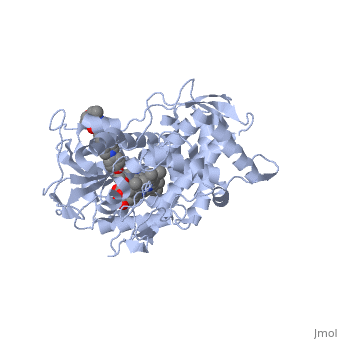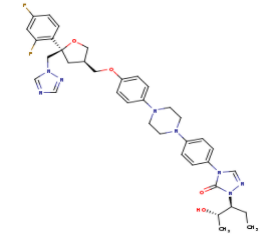Noxafil
From Proteopedia
(Difference between revisions)
| Line 12: | Line 12: | ||
*IUPAC name: 4-[4-[4-[4-[[(3R,5R)-5-(2,4-difluorophenyl)-5-(1,2,4-triazol-1-ylmethyl)oxolan-3-yl]methoxy]phenyl]piperazin-1-yl]phenyl]-2-[(2S,3S)-2-hydroxypentan-3-yl]-1,2,4-triazol-3-one | *IUPAC name: 4-[4-[4-[4-[[(3R,5R)-5-(2,4-difluorophenyl)-5-(1,2,4-triazol-1-ylmethyl)oxolan-3-yl]methoxy]phenyl]piperazin-1-yl]phenyl]-2-[(2S,3S)-2-hydroxypentan-3-yl]-1,2,4-triazol-3-one | ||
| - | The primary component of Noxafil, <scene name='75/756730/Posaconazole/1'>posaconazole</scene> is a potent, broad-spectrum antifungal drug. It was derived from a similar triazole antifungal agent, | + | The primary component of Noxafil, <scene name='75/756730/Posaconazole/1'>posaconazole</scene> is a potent, broad-spectrum antifungal drug. It was derived from a similar triazole antifungal agent, itraconazole. The differences in structure are that the chlorine substituents in the aromatic ring on the left-hand side of the images are replaced with fluorines and that the triazolone sidechain is hydroxylated in the posaconazole structure<ref name="drugbank">Posaconazole. (n.d.). Retrieved from https://www.drugbank.ca/drugs/DB01263 |
| - | Accession Number: DB01263 </ref>. The extended side chain residues | + | Accession Number: DB01263 </ref>. The extended side chain residues enhance antifungal activity by allowing tighter binding affinities to the <scene name='75/756730/Hemegroup2/1'>heme cofactor</scene> in the active site of the CYP450-dependent enzyme 14-alpha-demthylase (<scene name='75/756730/Cyp51/1'>CYP51</scene>) <ref name="groll">doi:10.1586/14787210.3.4.467</ref><ref>doi: 10.1086/523576</ref>. The tighter binding affinity of posaconazole makes it less susceptible to be affected by mutations in the enzyme resulting in resistance of fungi <ref name="formularyjournal">Sircar-Ramsewak,, F., Nicolau, D. P., & Kuti, J. L. (2005). Focus on posaconazole: A novel triazole antifungal for the treatment of invasive fungal infections. Formulary Journal - Modern Medicine Network </ref>. The entirety of the scene shows the crystal <scene name='75/756730/Structure/1'>structure</scene> of sterol 14-alpha demethylase (CYP51) from a pathogenic yeast Candida albicans in complex with the antifungal drug posaconazole (PDB ID: 5FSA). |
| Line 28: | Line 28: | ||
== Relevance == | == Relevance == | ||
| - | Invasive fungal infections, commonly caused by ''Candida'' or ''Aspergillus'' species affect patients that are immunocompromised such as those with different pre-existing infections or more seriously for those with immunologically suppressing diseases like HIV/AIDS. ''Candida'' (thrush/Candidiasis) is the most common yeast pathogen that typically grows in human mucosal surfaces like the intestinal tract and causes pathology when it becomes overgrown. ''Aspergillus'' is the most common mold pathogen leading to invasive fungal infections, termed Aspergillosis, when it is acquired from the surrounding environment <ref name="soysal">doi: 10.2147/IDR.S65592</ref>. Noxafil oral suspension is the | + | Invasive fungal infections, commonly caused by ''Candida'' or ''Aspergillus'' species affect patients that are immunocompromised such as those with different pre-existing infections or more seriously for those with immunologically suppressing diseases like HIV/AIDS. ''Candida'' (thrush/Candidiasis) is the most common yeast pathogen that typically grows in human mucosal surfaces like the intestinal tract and causes pathology when it becomes overgrown. ''Aspergillus'' is the most common mold pathogen leading to invasive fungal infections, termed Aspergillosis, when it is acquired from the surrounding environment <ref name="soysal">doi: 10.2147/IDR.S65592</ref>. Fungal resistance among these pathogens are becoming more frequent, requiring the development of new, more effective antifungal drugs. Noxafil oral suspension is the most effective form of treatment for invasive ''Candida'' and ''Aspergillus'' infections in patients 13 years and older who are severely immunocompromised. Noxafil is also more effective at preventing invasive fungal infections in immunocompromised patients when compared to other antifungal treatments (fluconazole and itraconazole)<ref name="dekkers">doi: 10.1007/s12281-016-0255-4</ref> . Overall, Noxafil displays fewer cases of invasive fungal infections and is also a more affordable treatment for immunocompromised patients. There has been a noticeable increase in the incidence of invasive fungal infections particularly within patients receiving chemotherapy and transplant recipients. These patients are extremely susceptible because of their compromised immune system and the pressures from antibiotic usage, which is why invasive fungal infections are on the rise with these medical advances <ref name= "dekkers"/>. |
| - | + | ||
== References == | == References == | ||
<references/> | <references/> | ||
Revision as of 02:13, 20 April 2017
| |||||||||||
Proteopedia Page Contributors and Editors (what is this?)
Madelyn Smith, Gianna Cutrone, Michal Harel, Kelley Barker, Hannah Ackleson


